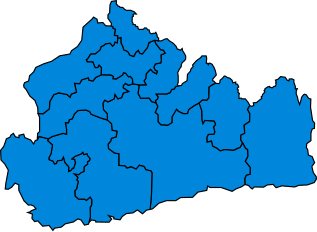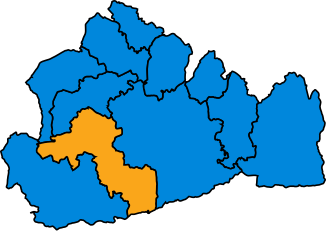Top Qs
Timeline
Chat
Perspective
Parliamentary constituencies in Surrey
From Wikipedia, the free encyclopedia
Remove ads
Remove ads
The ceremonial county of Surrey is divided into 11 parliamentary constituencies which are wholly within the county boundaries. In addition, there are two constituencies which cross the county boundary - one with Hampshire (Farnham and Bordon) and one with Berkshire (Windsor). These thirteen seats are sub-classified into three of borough type and ten of county status, affecting the level of expenses permitted and the status of the returning officer.
Surrey residents comprise a majority of the Farnham and Bordon constituency, with Hampshire residents in the minority. However, in the Windsor constituency Surrey residents comprise only a small minority, with the overwhelming majority being Berkshire residents. One might therefore say that there are effectively 12 ‘Surrey constituencies’ in all - 11 seats that are wholly in Surrey, plus the Farnham and Bordon constituency where Surrey residents are in the majority, where the Surrey town of Farnham is the main town within the seat, and where Surrey constitutes the majority of the land area of the seat.
The county saw the vast bulk of its population and seats removed on the creation of the County of London in 1889 and its wider replacement by the county of Greater London in 1965.
Reflecting its mainly suburban and rural nature, all seats covering the present definition of Surrey have been held by Conservative MPs at each general election since 1885, with the exception of three Liberals in 1906, one Liberal Democrat in 2001, and six Liberal Democrats in 2024.
Remove ads
Constituencies
† Conservative ‡ Labour ¤ Liberal Democrat
Remove ads
Historic list of constituencies in Surrey
Used from 1950 to 1974
- Chertsey
- Dorking
- Epsom
- Esher
- Farnham
- Guildford
- Reigate
- East Surrey
- Spelthorne (previous county: Middlesex abolished in 1965)
- Woking
Eleven other seats fell within the north-east of Surrey until 1965, forming the metropolitan part closest to London and the majority of the population (shown in the Historical Representation tables below). These were moved into Greater London leaving a predominantly suburban and rural content.
Used from 1974 to 1983
Used from 1983 to 1997
Remove ads
2010 boundary changes
Under the Fifth Periodic Review of Westminster constituencies, the Boundary Commission for England decided to retain the existing 11 constituencies in Surrey, with only very minor changes to four of them.
2024 boundary changes
Summarize
Perspective
See 2023 Periodic Review of Westminster constituencies for further details.
For the 2023 Periodic Review of Westminster constituencies, which redrew the constituency map ahead of the 2024 United Kingdom general election, the Boundary Commission for England opted to combine Surrey with Berkshire and Hampshire as a sub-region of the South East Region.
As a result, the majority of the abolished constituency of South West Surrey was combined with parts of the constituency of East Hampshire to form a cross-county boundary constituency named Farnham and Bordon. The remainder of South West Surrey was combined with parts of Guildford, Mole Valley and Surrey Heath to form the new constituency of Godalming and Ash. The communities of Englefield Green and Virginia Water in the borough of Runnymede were included in the Berkshire constituency of Windsor. Following some significant changes to Mole Valley, this constituency was renamed Dorking and Horley.[2][3][4]
The eleven boroughs and districts that constitute the modern county of Surrey contributed to the twelve Surrey constituencies (plus the Berkshire constituency of Windsor) as follows:
Containing electoral wards from Elmbridge
Containing electoral wards from Epsom and Ewell
- Epsom and Ewell (part)
Containing electoral wards from Guildford
- Guildford
- Surrey Heath (part)
- Godalming and Ash (part)
Containing electoral wards from Mole Valley
- Dorking and Horley (part)
- Epsom and Ewell (part)
Containing electoral wards from Reigate and Banstead
- Dorking and Horley (part)
- East Surrey (part)
- Reigate
Containing electoral wards from Runnymede
- Runnymede and Weybridge (part)
- Windsor (parts also in the Boroughs of Slough, and Windsor and Maidenhead in Berkshire)
Containing electoral wards from Spelthorne
Containing electoral wards from Surrey Heath
- Surrey Heath (part)
Containing electoral wards from Tandridge
- East Surrey (part)
Containing electoral wards from Waverley
- Dorking and Horley (part)
- Farnham and Bordon (part also in the District of East Hampshire)
- Godalming and Ash (part)
Containing electoral wards from Woking
Remove ads
Results history
Summarize
Perspective
Primary data source: House of Commons research briefing – General election results from 1918 to 2019[5]
2024
The number of votes cast for each political party that fielded candidates in the twelve constituencies comprising Surrey in the 2024 general election were as follows in the chart below:[nb 3]
(N.B. In 2024, the Conservative Party lost five seats on their previous total of holding all eleven Surrey constituencies at the 2019 general election. However, given that all twelve revised Surrey seats in 2024 - including the ‘new’ seat of Godalming and Ash - had all been notionally Conservative on the 2019 results, one might equally well argue that the Conservatives lost six Surrey seats in 2024, half of the total).
Percentage votes
Note that before 1974 Surrey included a considerable part of what is now London.
1pre-1979 – Liberal Party; 1983 & 1987 – SDP-Liberal Alliance
* Included in Other
Accurate vote percentages cannot be obtained for the elections of 1918, 1922, 1923 and 1931 because at least one candidate stood unopposed.
Seats
11974 & 1979 – Liberal Party; 1983 & 1987 – SDP-Liberal Alliance
General Election 2019, 2017, 2015 and 2010 results
The following tables show the results for all Surrey constituencies in the General Elections in 2019, 2017, 2015 and 2010. The results are given as percentages.
Maps
1885–1910
- 1885
- 1886
- 1892
- 1895
- 1900
- 1906
- Jan 1910
- Dec 1910
1918–1945
- 1918
- 1922
- 1923
- 1924
- 1929
- 1931
- 1935
- 1945
1950–1970
- 1950
- 1951
- 1955
- 1959
- 1964
- 1966
- 1970
1974–2019
- Feb 1974
- Oct 1974
- 1979
- 1983
- 1987
- 1992
- 1997
- 2001
- 2005
- 2010
- 2015
- 2017
- 2019
2024-present (including constituencies partly in Berkshire and Hampshire)
- 2024
Remove ads
Historical representation by party
Summarize
Perspective
A cell marked → (with a different colour background to the preceding cell) indicates that the previous MP continued to sit under a new party name.
1885 to 1918
Conservative Liberal Liberal Unionist National Party
Note the 15 other seats of Surrey created in 1885 which primarily or wholly lay in the 1889-created County of London are not included in this list.
1918 to 1950 (12, then 14 MPs)
Conservative Independent Conservative Labour
† denotes seat which falls wholly or largely within present-day county of Greater London.
1950 to 1974 (19, then 20 MPs)
† denotes seat which falls wholly or largely within present-day county of Greater London
1974 to 1997 (11 MPs)
In 1965 half (ten) of Surrey's constituencies were moved to the new county of Greater London, but constituencies based on the old boundaries continued to be used until 1974, when Surrey gained one constituency (Spelthorne) from the abolished administrative county of Middlesex.
1997 to present (11, then 12 MPs)
Liberal Democrat MP Sue Doughty, who won Guildford in 2001 with a winning margin of 1.2%, was the first candidate to take a seat from the Conservatives in any part of the area covered by the present county of Surrey in 56 years.
Conservative Independent Liberal Democrats
1contains some parts of Hampshire
Remove ads
See also
Notes
- BC denotes borough constituency, CC denotes county constituency.
- The majority is the number of votes the winning candidate receives more than their nearest rival.
- Vote shares include the cross-county constituency of Farnham and Bordon which has a majority Surrey electorate, and excludes the cross-county constituency of Windsor which has a majority Berkshire electorate.
References
Wikiwand - on
Seamless Wikipedia browsing. On steroids.
Remove ads






























